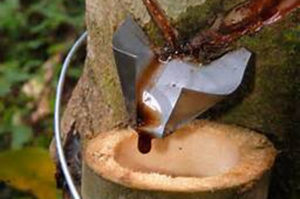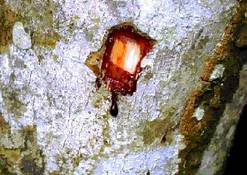Sangre de Grado is a tree that grows in the Amazon region of South America. The tree bark and sap are used to make medicine.
Sangre de Grado or SP-303, one of the chemicals it contains, is used for diarrhea associated with cholera, AIDS, traveling, or treatment with antibiotics. Sangre de Grado is also used for treating cancer, irritable bowel syndrome (IBS), viral respiratory infections, fever, hemorrhage, bleeding gums, wounds, broken bones, vaginal infections, hemorrhoids, a skin condition called eczema, and insect bites and stings. Other uses include treating ulcers of the mouth, throat, stomach, or intestine; supporting the body’s tissue repair mechanisms; and as a general tonic.
TRIBAL AND HERBAL MEDICINE USES
Sangre de grado’s red sap or latex (and also its bark) has a long history of indigenous use in the rainforest and in South America. The earliest written reference dates its use to the 1600s, when Spanish naturalist and explorer P. BernabéCobo found that the curative power of the sap was widely known throughout the indigenous tribes of Mexico, Peru, and Ecuador. For centuries, the sap has been painted on wounds to staunch bleeding, to accelerate healing, and to seal and protect injuries from infection. The sap dries quickly and forms a barrier, much like a “second skin.”  It is used externally by indigenous tribes and local people in Peru for wounds, fractures, and hemorrhoids, internally for intestinal and stomach ulcers, and as a douche for vaginal discharge. Other indigenous uses include treating intestinal fevers and inflamed or infected gums, in vaginal baths before and after childbirth, for hemorrhaging after childbirth, and for skin disorders.
It is used externally by indigenous tribes and local people in Peru for wounds, fractures, and hemorrhoids, internally for intestinal and stomach ulcers, and as a douche for vaginal discharge. Other indigenous uses include treating intestinal fevers and inflamed or infected gums, in vaginal baths before and after childbirth, for hemorrhaging after childbirth, and for skin disorders.
Sangre de grado resin and bark are used in traditional medicine in South America today in much the same manner as indigenous ones. In Peruvian herbal medicine it is recommended for hemorrhaging, as an antiseptic vaginal douche and, topically, for healing wounds. It is also used internally for ulcers in the mouth, throat, intestines and stomach; as an antiviral for upper respiratory viruses, stomach viruses and HIV; internally and externally for cancer and, topically, for skin disorders, insect bites and stings. In Brazilian traditional medicine the sap currently is used for wounds, hemorrhaging, diarrhea, mouth ulcers, and as a general tonic.
PLANT CHEMICALS
Sangre de grado resin or sap is a storehouse of phytochemicals including proanthocyanidins (antioxidants), simple phenols, diterpenes, phytosterols, and biologically active alkaloids and lignans Scientists have attributed many of the biologically active properties of the sap (especially its wound-healing capacity) to two main “active” constituents: an alkaloid named taspine, and a lignan named dimethylcedrusine.
Of course, botanists, herbalists, and naturopaths would disagree with such reductionist conclusions (and often do); in this particular case, the matter is actually proven by science. Noted author and ex-USDA economic botanist Dr. James Duke summed this up eloquently, saying, “I like the comments on dragon’s blood, and would add one further note: in addition to the proanthocyanadins (including Pycnogenol) and taspine, there’s another active ingredient – dimethylcedrusine. While each of these alone – dimethylcedrusine, Pycnogenol and taspine – was shown to effectively heal wounded rats (with squares of skin exfoliated, i.e., peeled off) by European scientists, the whole dragon’s blood was shown to speed healing four times faster. The whole was better than the sum of its parts. Synergy makes the whole herb stronger; diversity makes the rainforest stronger.”
The taspine alkaloid from sangre de grado was first documented with anti-inflammatory actions in 1979. In 1985 taspine was documented with anti-inflammatory, antitumorous (against sarcomas), and antiviral actions.
 The main plant chemicals in sangre de grado include: alpha-calacorene, alpha-copaene, alpha-pinene, alpha-thujene, beta-caryophyllene, beta-elemene, beta-pinene, betaine, bincatriol, borneol, calamenene, camphene, catechins, cedrucine, crolechinic acid, cuparophenol, D-limonene, daucosterol, dihydrobenzofuran, dimethylcedrusine, dipentene, eugenol, euparophenol, gallocatechin, gamma-terpinene, gamma-terpineol, hardwickiic acid, isoboldine, korberin A & B, lignin, linalool, magnoflorine, methylthymol, myrcene, norisoboldine, p-cymene, proanthocyanidins, procyanidins, resin, tannin, taspine, terpinen-4-ol, and vanillin.
The main plant chemicals in sangre de grado include: alpha-calacorene, alpha-copaene, alpha-pinene, alpha-thujene, beta-caryophyllene, beta-elemene, beta-pinene, betaine, bincatriol, borneol, calamenene, camphene, catechins, cedrucine, crolechinic acid, cuparophenol, D-limonene, daucosterol, dihydrobenzofuran, dimethylcedrusine, dipentene, eugenol, euparophenol, gallocatechin, gamma-terpinene, gamma-terpineol, hardwickiic acid, isoboldine, korberin A & B, lignin, linalool, magnoflorine, methylthymol, myrcene, norisoboldine, p-cymene, proanthocyanidins, procyanidins, resin, tannin, taspine, terpinen-4-ol, and vanillin.
CURRENT PRACTICAL USES
Research has confirmed many of the indigenous uses of this powerful rainforest plant. It is a wonderful, sustainable rainforest resource that warrants consumer attention as it becomes more widely available in the marketplace. Applied directly to the affected area, it is helpful for all types of cuts, scrapes, external wounds, bites, stings, rashes, and skin problems, including skin and nail fungi. Dr. James E. Williams, O.M.D., sums up sangre de grado’s many uses by natural health practitioners, stating,
“There is a wide range of potential applications for sangre de grado, including as a broad-spectrum anti-diarrheal agent from causes such as side effects of drugs, chemotherapy or radiation treatment, microbial infections of the intestine, traveler’s diarrhea, and viral-induced diarrhea as in AIDS. It may also have other uses in gastrointestinal disorders such as irritable bowel syndrome and ulcerative diseases. Its cytotoxic effects make it a possible antitumor agent and its cicatrizant properties provide wound-healing potential. In addition, the antimicrobial and anti-inflammatory effects of sangre de grado make it a useful compound in the clinical treatment of chronic viral diseases and as a natural antibacterial agent.”
In addition, several health practitioners in the U.S. indicate benefits in using sangre de grado resin internally for diabetic neuropathy because of its previously documented effects on nerve endings, nerve pain and nerve inflammation. Benefits have also been reported with diabetes-related skin ulcers and sores (applied topically) which have refused to heal using other methods.
